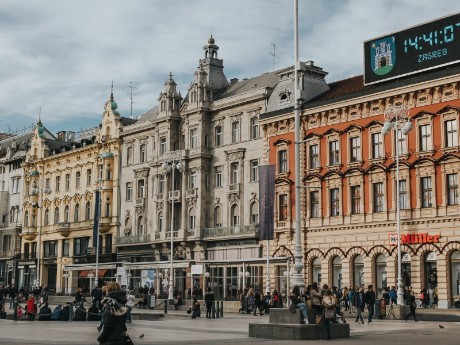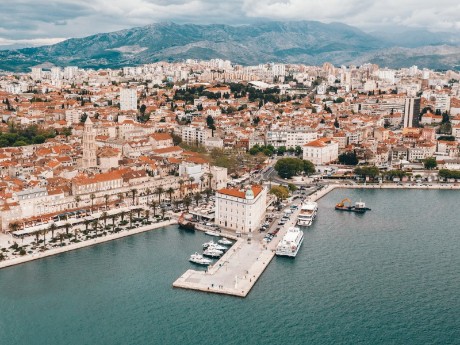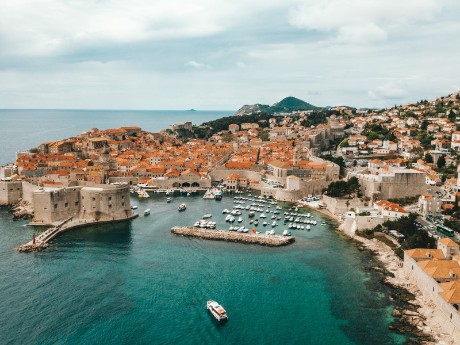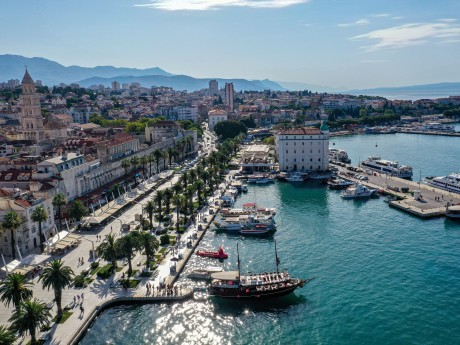Croatia: Zagreb, Split & Dubrovnik
Embark on an unforgettable journey through Croatia as you discover the historic charm of Zagreb's Upper Town, bask in the sun-kissed coastal beauty of Split's Diocletian's Palace, and wander the ancient walls of Dubrovnik's Old Town. Begin in Zagreb's Upper Town, where cobbled streets wind their way past stunning Gothic and Baroque architecture, offering a glimpse into the city's rich history.
Read more
Embark on an unforgettable journey through Croatia as you discover the historic charm of Zagreb's Upper Town, bask in the sun-kissed coastal beauty of Split's Diocletian's Palace, and wander the ancient walls of Dubrovnik's Old Town. Begin in Zagreb's Upper Town, where cobbled streets wind their way past stunning Gothic and Baroque architecture, offering a glimpse into the city's rich history. In Split, immerse yourself in the captivating embrace of Diocletian's Palace, an ancient Roman residence that has transformed into a vibrant hub of shops, cafes, and culture, all nestled against the glistening Adriatic backdrop. Step back in time within the enchanting walls of Dubrovnik’s Old Town, where terracotta rooftops contrast with the azure sea, creating a picturesque scene that's straight out of a postcard. Don't miss the chance to savour Croatia's culinary delights, from fresh seafood by the coast to hearty traditional dishes in cozy inland taverns. To maximize your experience, a ferry ride between Split and Dubrovnik is recommended. Tickets can be purchased locally. Waterviews strives to offer accommodation options within walking distance of water and/or in an area of touristic interest. Our prices include taxes (but excludes local tourist taxes). Customize your trip to your personal preferences with optional activities (hit the “Add Activities’’) or change hotels, etc. Contact us for customization at no extra cost at: Service@waterviewstravel.com
Destinations
- Zagreb
- Split
- Dubrovnik
Itinerary
Zagreb

Croatia's vibrant capital is a bustling hub of history and culture, attracting flocks of crowds who come to marvel at its stunning architecture and enjoy its lively atmosphere. The city’s Upper Town is a picturesque sight of medieval cobbled streets that are filled with ancient churches, charming cafes and quaint bars, and the lower district is Zagreb’s buzzing centre where sprawling squares and wide boulevards house excellent shops, world-class museums and an impressive collection of 18th and 19th century Austro-Hungarian buildings.
Read more
Croatia's vibrant capital is a bustling hub of history and culture, attracting flocks of crowds who come to marvel at its stunning architecture and enjoy its lively atmosphere. The city’s Upper Town is a picturesque sight of medieval cobbled streets that are filled with ancient churches, charming cafes and quaint bars, and the lower district is Zagreb’s buzzing centre where sprawling squares and wide boulevards house excellent shops, world-class museums and an impressive collection of 18th and 19th century Austro-Hungarian buildings.
Additional Information
Zagreb is a vibrant city of around 800,000 people (metropolitan area: 1,200,000). The city boasts a charming medieval 'old city' with architecture and cobbled streets reminiscent of Vienna, Budapest, Prague and other Central-European capitals. In 2017 it was visited by over a million tourists, mainly from Austria, Germany and Italy. Zagreb is also well known for its Advent festival, which occurs from December to early January, boasting vibrant nightlife and extra events not available in other parts of the year.
Tourist information
Other information points are located at the airport, bus station, railway station and at the Lotrščak Tower.
© Sourced from Wikivoyage
Split

The coastal city of Split is one of Croatia's finest, known as a holiday hotspot due to its picturesque Old Town, vibrant atmosphere and sun-soaked climate. Marvel at the vast Roman Diocletian's Palace and the ancient Saint Domnius Cathedral, admire the sculptures in the Mestrovic Gallery, stroll along the palm-lined promenade and enjoy the countless restaurants, cafes and bars that bustle with locals and visitors until the early hours. The city is also the gateway to some of the country's most scenic islands and boasts some excellent beaches.
Read more
The coastal city of Split is one of Croatia's finest, known as a holiday hotspot due to its picturesque Old Town, vibrant atmosphere and sun-soaked climate. Marvel at the vast Roman Diocletian's Palace and the ancient Saint Domnius Cathedral, admire the sculptures in the Mestrovic Gallery, stroll along the palm-lined promenade and enjoy the countless restaurants, cafes and bars that bustle with locals and visitors until the early hours. The city is also the gateway to some of the country's most scenic islands and boasts some excellent beaches.
Additional Information
Because of its ideal climate, with 2,800 hours of sunlight each year, local people have a few nicknames for Split: "The most beautiful city in the world" and "Mediterranean flower". Many famous Croatian sports people were born in Split, so locals often nicknamed their city "The sportiest city in the world". The most popular sport institution is the football club Hajduk. Large portions of the city are painted with the club's colors and logo. This is done by Torcida, the oldest supporters group in Europe, established in 1950.
Besides the bell tower of St. Duje, the symbols of city are the Dalmatian dog and a donkey. Locals have a high regard for the donkey because of its past indispensable place in field work and transport across the Dalmatian mountains.
Winters in Split are generally mild, with temperatures above 0°C, but despite the popular saying that the city experiences snowfall once every 30 years, there is actually at least one snowy day nearly every winter, usually in January or early February. If you find yourself in Split on a day with significant snowfall, expect serious traffic disruption.
Tourist information
© Sourced from Wikivoyage
Dubrovnik

Set on Croatia’s sparkling blue coastline and surrounded by ancient city walls, Dubrovnik is a historic jewel that has rightfully earned its nickname as the ‘Pearl of the Adriatic’. Boasting UNESCO World Heritage Site status, the Old Town is an evocative blend of honey-hued Baroque, Renaissance and Gothic architecture and limestone-paved streets that are sure to enchant everyone who visits. From palaces, churches and museums to picturesque beaches, incredible islands and scenic hilltop views, Dubrovnik has it all.
Read more
Set on Croatia’s sparkling blue coastline and surrounded by ancient city walls, Dubrovnik is a historic jewel that has rightfully earned its nickname as the ‘Pearl of the Adriatic’. Boasting UNESCO World Heritage Site status, the Old Town is an evocative blend of honey-hued Baroque, Renaissance and Gothic architecture and limestone-paved streets that are sure to enchant everyone who visits. From palaces, churches and museums to picturesque beaches, incredible islands and scenic hilltop views, Dubrovnik has it all.
Additional Information
The city of Dubrovnik (Latin: Ragusa) was built on maritime trade. In the Middle Ages it became the only city-state in the Adriatic to rival Venice. Supported by its wealth and skilled diplomacy, the city achieved a remarkable level of development during the 15th and 16th centuries. Furthermore, Dubrovnik was one of the centres of the development of the Croatian language and literature, home to many notable poets, playwrights, painters, mathematicians, physicists and other scholars.
Today Dubrovnik is the proudest feather in Croatia's tourist cap, an elite destination, and one of the most beautiful towns in the Mediterranean. Just like many destinations in the Adriatic, it is much more expensive and tourism centered than other places in Croatia. It has managed to survive many centuries, with constant threats to its territory, particularly from the mighty Ottoman Empire and Venice. As early as the 19th century, it was discovered by celebrities as a place to be seen. George Bernard Shaw once said that "those who seek paradise on Earth should come to Dubrovnik and find it". Royalty, presidents and diplomats have all favored the city. The late Pope John Paul II was a fan of Dubrovnik and was even made an honorary citizen. Of the 23 top luxury hotels in Croatia in 2010, 13 were in Dubrovnik.
Dubrovnik is steeped in stunning architecture and sculptural detail, and boasts spectacular churches, monasteries, museums, and fountains. A multitude of typical towns and excursions include: the Elaphiti Islands, the attractive town of Cavtat, the Konavle valley, Mljet Island, Korčula Island, Ston and Peljesac Peninsula. The neighbouring towns of Kotor and Perast in Montenegro or Mostar in Bosnia and Herzegovina also make for intriguing day trips.
© Sourced from Wikivoyage





